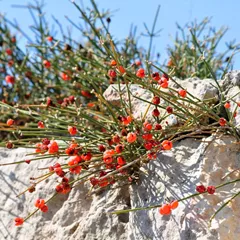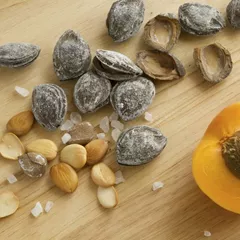Da Qing Long Tang
Da Qing Long Tang
Chinese: 大青龙汤
Pinyin: Dà Qīng Lóng Tāng
Other names: Major Blue Green Dragon Decoction




Da Qing Long Tang
Da Qing Long Tang
Chinese: 大青龙汤
Pinyin: Dà Qīng Lóng Tāng
Other names: Major Blue Green Dragon Decoction
Number of ingredients: 7 herbs
Formula category: Formulas that clear Wind-Cold
- Promotes sweating
- Releases the Exterior
- Clears Interior Heat
Contraindications: This formula is strongly diaphoretic (induces sweating). It should be... This formula is strongly diaphoretic (induces sweating). It should be administered gradually and stopped once sweating has been induced. The formula is contraindicated in lesser Yin patterns, in cases of Yang Deficiency, in Wind-Stroke patterns with Deficiency of the Exterior, and in all cases where sweating is associated with an increase in irritability, restlessness, and Heat (i.e., cases of Yin or Blood Deficiency). It is also inappropriate for Wind-Cold fettering the Exterior with severe accumulation of Fluids in the Interior. see more
Source date: 220 AD
Source book: Discussion of Cold Damage
The information provided here is not a replacement for a doctor. You shouldn't use it for the purpose of self-diagnosing or self-medicating but rather so you can have a more informed discussion with a professional TCM practitioner.
Da Qing Long Tang is a 7-ingredient Chinese Medicine formula with Ephedra (Ma Huang) as a principal ingredient.
Invented in 220 AD, it belongs to the category of formulas that clear Wind-Cold. Its main actions are: 1) promotes sweating and 2) releases the Exterior.
On this page, after a detailed description of each of the seven ingredients in Da Qing Long Tang, we review the patterns and conditions that Da Qing Long Tang helps treat.
The seven ingredients in Da Qing Long Tang

Ma Huang is a king ingredient in Da Qing Long Tang. Like the name indicates, it means it has more power than other ingredients in the formula.
1. Ephedra (Ma Huang)
In general Ma Huang's main actions are as follows: "Releases the surface through sweating. Promotes the circulation of Lung Qi and stop wheezing. Promotes urination."
In the context of Da Qing Long Tang, it is used because it is a particularly strong diaphoretic that also disseminates the Lung Qi and treats wheezing.

Shi Gao is a deputy ingredient in Da Qing Long Tang. This means it helps the king ingredient(s) treat the main pattern or it serves to treat a coexisting pattern.
2. Gypsum (Shi Gao)
Part used: The mineral itself
Nature: Cold
Meridian affinity: LungStomach
Category: Herbs that clear Heat and purge Fire and/or clear Summer Heat
Shi Gao clears Internal Heat without inhibiting the dispersing action of the diaphoretics or further damaging the Yin Fluids.

Gui Zhi is an assistant ingredient in Da Qing Long Tang. This means that it either serves to reinforces the effect of other ingredients or it moderates their toxicity.
3. Cinnamon Twigs (Gui Zhi)
Gui Zhi works together with Fresh ginger (Sheng Jiang), another assistant herb of this formula, to assist the key herb - Ephedra (Ma Huang) - in strongly opening the pores, inducing sweating, and scattering Wind-Cold.

Sheng Jiang is an assistant ingredient in Da Qing Long Tang. This means that it either serves to reinforces the effect of other ingredients or it moderates their toxicity.
4. Fresh Ginger (Sheng Jiang)
In general Sheng Jiang's main actions are as follows: "Relieves the Exterior and disperses Cold. Warms and circulates Qi in the Middle Burner. Calms a restless fetus and treats morning sickness. Treats seafood poisoning."

Da Zao is an assistant ingredient in Da Qing Long Tang. This means that it either serves to reinforces the effect of other ingredients or it moderates their toxicity.
5. Jujube Dates (Da Zao)
Part used: Dried ripe fruit
Nature: Warm
Taste(s): Sweet
Meridian affinity: SpleenStomach
Category: Tonic herbs for Qi Deficiency
Da Zao works together with Liquorice (Gan Cao), another assistant herb here, to tonify the Middle Burner Qi and provide the Essence from which the Fluids can be replenished. They actively facilitate sweating in a context where Fluids may have been damaged by Internal Heat, while also moderating the drying action of the acrid and warming diaphoretic herbs.

Gan Cao is an assistant ingredient in Da Qing Long Tang. This means that it either serves to reinforces the effect of other ingredients or it moderates their toxicity.
6. Liquorice (Gan Cao)
Part used: Dried root and rhizome
Nature: Neutral
Taste(s): Sweet
Meridian affinity: HeartLungSpleenStomach
Category: Tonic herbs for Qi Deficiency
In general Gan Cao's main actions are as follows: "Tonifies the Basal Qi and nourishes the Spleen Qi. Clears Heat and dispels toxicity. Moistens the Lungsexpel phlegm and stop coughing. Relieves spasms and alleviates pain. Harmonizes and moderates the effects of other herbs."

Xing Ren is an assistant ingredient in Da Qing Long Tang. This means that it either serves to reinforces the effect of other ingredients or it moderates their toxicity.
7. Apricot Seeds (Xing Ren)
Part used: Dried ripe seeds
Nature: Warm
Meridian affinity: Large intestineLung
Category: Herbs that relieve coughing and wheezing
Xing Ren directs Lung Qi downward and balances the dispersive action of the key herb here, Ephedra (Ma Huang). Also, its oily nature moderates the damage to the Lungs made by Ephedra's drying effect.
Conditions and patterns for which Da Qing Long Tang may be prescribed

Body Fluids (Jin Ye) is one of Chinese Medicine's vital subtances. Learn more about Body Fluids in Chinese Medicine
Phlegm-Fluids in the limbs
Pulse type(s): Tight (Jin), Wiry (Xian)
Tongue coating: Sticky coating, Thick white coating
Tongue shape: Swollen
Symptoms: Thirst No sweat No thirst Irritability Swollen limbs Restlnessness No desire to drink Urinary difficulty Pain in the muscles Absence of sweating Feeling of heaviness Generalized body pain Feeling of heaviness of body Alternating fever and chills Coughing with copious white sputum Superficial edema in the extremities Coughing of copious thin and white sputum
Da Qing Long Tang is sometimes prescribed by TCM practitioners to treat Phlegm-Fluids in the limbs. This pattern leads to symptoms such as feeling of heaviness of body, pain in the muscles, no sweat and no desire to drink. Patients with Phlegm-Fluids in the limbs typically exhibit tight (Jin) or wiry (Xian) pulses as well as Swollen tongue with sticky white coating.
Essential Prescriptions from the Golden Cabinet, a classic Chinese Medicine book written almost 2,000 years ago by Zhang Zhongjing (150-219), defines Phlegm-Fluids in the limbs (Yi Yin) as follows: "The Fluids flow [throughout the entire body] and come together in the four limbs. They should issue... read more about Phlegm-Fluids in the limbs

The Interior in Chinese Medicine is one of the so-called "Eight Principles". Learn more about Interior in Chinese Medicine
Exterior Cold invading with Interior Heat from Stagnation
Pulse type(s): Floating (Fu), Tight (Jin)
Symptoms: Thirst Irritability Generalized body pain Severe fever and chills without sweating
Da Qing Long Tang is sometimes prescribed by TCM practitioners to treat Exterior Cold invading with Interior Heat from Stagnation. This pattern leads to symptoms such as severe fever and chills without sweating, generalized body pain, thirst and irritability. Patients with Exterior Cold invading with Interior Heat from Stagnation typically exhibit floating (Fu) or tight (Jin) pulses.
Learn more about Exterior Cold invading with Interior Heat from Stagnation
Formulas similar to Da Qing Long Tang
Ge Gen Tang is 71% similar to Da Qing Long Tang
Ma Huang Tang is 57% similar to Da Qing Long Tang
Ma Xing Shi Gan Tang is 57% similar to Da Qing Long Tang
Gui Zhi Tang is 57% similar to Da Qing Long Tang
Gui Zhi Shao Yao Zhi Mu Tang is 44% similar to Da Qing Long Tang
Jin Fei Cao San is 44% similar to Da Qing Long Tang










